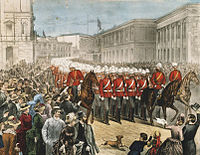New South Wales Contingent
| New South Wales Contingent | |
|---|---|

Departure of the NSW Contingent, 1885.
|
|
| Active | 1885 |
| Country | New South Wales |
| Allegiance | British Empire |
| Size | ~ 770 men and 200 horses |
| Part of | Suakin Expedition |
| Engagements | Mahdist War |
| Battle honours | Suakin 1885 |
| Disbanded | 1885 |
| Commanders | |
| Commanding Officer | John Soame Richardson |
The New South Wales Contingent served in Sudan with British forces as part of the Suakin Expedition in 1885. Consisting of an infantry battalion, an artillery battery, and a small field ambulance detachment, it departed from Sydney on 3 March 1885. Arriving at Suakin on 29 March it ultimately saw little action, being involved in a minor action at Tamai on 3 April, and another at Takdul on 6 May. However, with the British deciding to abandon the campaign it re-embarked on 17 May and returned to Sydney on 19 June 1885, where it was disbanded. The New South Wales Contingent was the first military contingent to be raised and deployed overseas by an Australian colony.
During the early years of the 1880s, an Egyptian regime in the Sudan, backed by the British, came under threat from rebellion under the leadership of native Muhammad Ahmad (or Ahmed), known as Mahdi to his followers. In 1883, as part of the Mahdist War, the Egyptians sent an army to deal with the revolt, but they were defeated and faced a difficult campaign of extracting their forces. The British instructed the Egyptians to abandon the Sudan, and sent General Charles Gordon to co-ordinate the evacuation, but he was killed on 26 January 1885 during the fall of Khartoum. When news of his death arrived in New South Wales in February 1885, the government offered to send forces and meet the contingent's expenses. The British government subsequently accepted the offer, although similar commitments from Victoria, Queensland, and South Australia were declined. The New South Wales Contingent consisted of an infantry battalion of 522 men and 24 officers, and an artillery battery of 212 men, a small field ambulance detachment, and 200 horses, led by Colonel John Soame Richardson, sailed from Sydney on 3 March 1885, aboard the ships Iberia and Australasian. A large crowd of more than 200,000 people saw them off, while the dispatch of the contingent was portrayed in a number of contemporary newspapers as the "coming of age" of the Australian colonies.
...
Wikipedia
